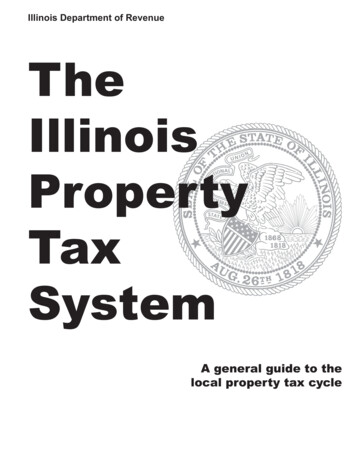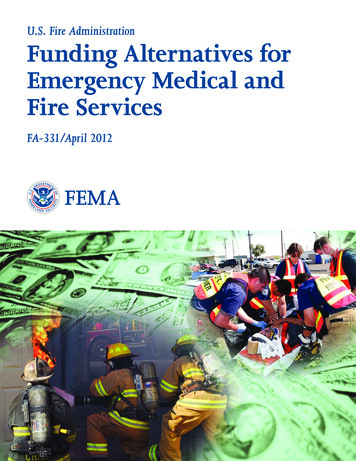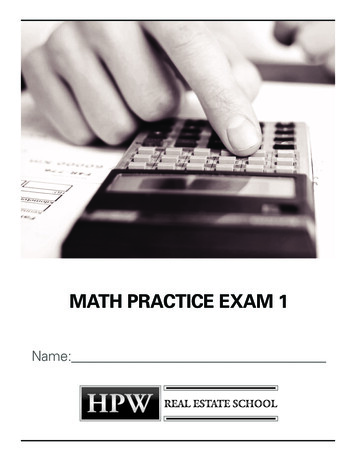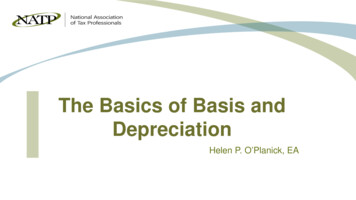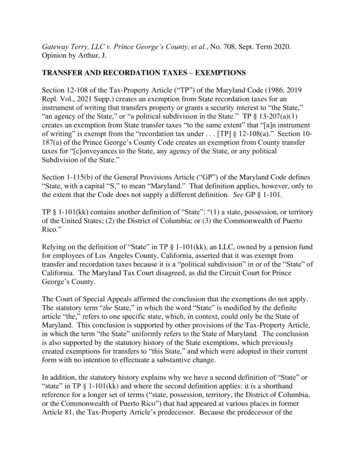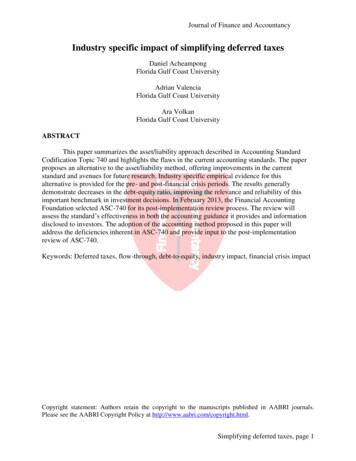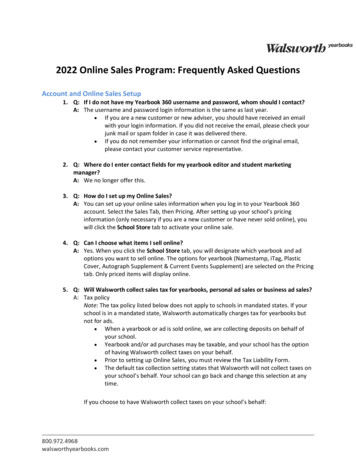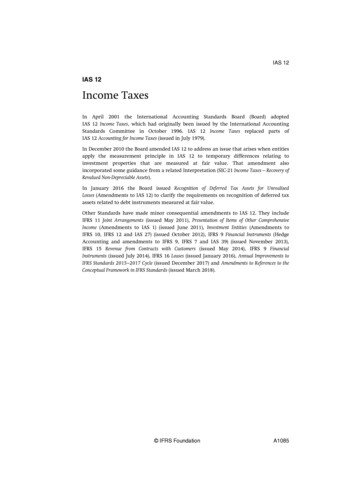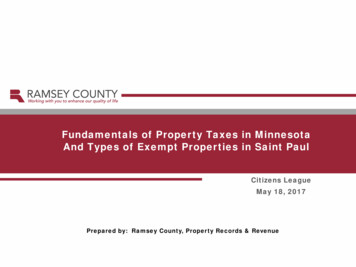
Transcription
Fundamentals of Property Taxes in MinnesotaAnd Types of Exempt Properties in Saint PaulCitizens LeagueMay 18, 2017Prepared by: Ramsey County, Property Records & Revenue
OverviewOverview Minnesota has one of the most complex property tax systems in thenation Most local officials understand some aspects of property taxes, but notthe total picture Goal today is not to make you property tax experts, but to increase yourunderstanding of the system2
Property Tax MythsSeven Myths About Property Taxes1.Property taxes always go up2.Market value increases generate more revenue3.Property taxes paid are directly tied to servicesreceived4.Property taxes are based on an ability to pay5.There is a limit on how much property taxes on a givenproperty can go up in a year6.Local taxing authorities have more than a marginalability to change property taxes7.Property taxes for homes are high in Minnesotarelative to other states3
Who Determines Your Property Tax?State Legislature Sets Property Tax Policy Establishes Property Classes & Class Rates Determines Levels of State Aid Underfunded Mandates toLocal Governments Levies State Business TaxProperty TaxTaxing Jurisdictions Determines Levy AmountCounty Assessor Determines Market Value Assigns Property Class4
State RolesState Legislature Roles The State Legislature affects property taxes in many ways, including:– Determining who pays taxes– Setting “class rates” and definitions of tax capacity and referendummarket value– Setting levy limits for taxing jurisdictions– Paying state aids and credits– Levying a state property tax– Oversight, Equalization, Training and Administration5
State Roles - ClassificationClass Rates Class rates are varying percentages multiplied times taxable marketvalue to determine net tax capacity Class rates are set in state law Since most taxes are spread on net tax capacity, differences in classrates lead to differences in taxes paid6
State Roles – Levy LimitsState-Imposed Levy Limits State has imposed levy limits on school district taxes every year since1971 School levy limits can be exceeded only through voter approval for: bond issues operating referendums capital project levies In some years, the state has also imposed general limits on city,township, and county levies Limits tend to be based on prior year’s levies, adjusted for inflation andpopulation change No general limits on city, township, and county levies for taxes payablein 2017 Special purpose levy limits apply to levies for certain purposes7
State Roles – Aids and CreditsState Aids and CreditsState pays a variety of aids and credits that affect property taxes State funds go to both individual taxing jurisdictions and directly totaxpayers Aid and credits are calculated/paid at four different stages of the propertytax process All have some effect on who pays and how much they pay8
State Roles – Aids and CreditsState Aids and Credits1.Before Levy Certification (may reduce property tax levies by providing an alternatesource of revenue) Education aids Local government aid County program aid Others2.During Tax Rate Calculation (provides a uniform rate reduction for all property in aUTA) Disparity Reduction Aid3.After Tax Rate Calculation (provides tax reduction to some property owners) Ag Market value based homestead credits Disaster credits4.After taxes paid (refunds paid to taxpayers who qualify) Minnesota Property Tax Refund (aka “Circuit Breaker”) Targeted Refund9
State Roles – Aids and CreditsHomestead Market Value Exclusion Replaces market value homestead credit with an exclusion on homesteadproperty equal to 40% of 1st 76K of market value less 9% of value over 76K but less than 413,800. State doesn’t pay to reduce homestead property taxes – instead reducesvalue used for local taxes on homestead property to provide a benefit. In2012 essentially shifted 23.5 million in property taxes from the state tolocal taxpayers, but protects homesteads. Change effective for Pay 2012 taxes and thereafter10
State Roles – State General TaxState General Property Tax State imposed a general property tax, beginning in 2002, on: commercial-industrial, public utility, and railroad operating property seasonal resorts, and seasonal recreational residential property (cabins) The state-wide tax capacity rates for 2017 are: Commercial, industrial, and public utility 45.802% Cabins20.845% For cabins, a reduced class rate is used for the first 76,000 For this tax, tax capacities are not reduced for tax increment or fiscaldisparities This is a significant tax for these properties Taxes are levied and collected by counties and paid to State11
Assessor RolesCounty Assessor’s Role Determines the Estimated Market Value (“EMV”) for each propertybased on activity in the real estate market Determines the taxable or exempt status of each property Assigns classification (“class”) codes to each property based on theproperty’s useDefinition of Real Property Real property refers to the bundle of rights connected with real estate.Some of these rights could include the right to occupy the real estate,sell it, lease it, enter it, give it away, or borrow against it.12
Assessor Roles Examples of exempt property Cemeteries Public hospitals Education institutions Church property Institutions of purely public charity Public property used exclusively for any publicpurposes13
Saint Paul Exempt ValuesPay 2016 – Saint Paul Exempt Values by Type of PropertyType of ExemptionSchoolsK-12 - PublicK-12 - PrivateCollege - PublicCollege - PrivateRes - K-12 - PrivateRes - College - PrivateCemeteryPrivateChurchChurchResRes - OtherOtherHospitalPublicPrivateCharitable InstitutionCharitable InstitutionResApprenticeship Training FacilitiesEmergency Shelters for Victims of Domestic AbuseSenior Citizen FacilityElderly Living FacilityTransitional HousingIce Arenas/Baseball Parks owned by non-profitsChildren's HomesEstimated Market Value # of 244571011121% of totalEXEMPT %0.0%0.1%0.0%14
Saint Paul Exempt ValuesPay 2016 – Saint Paul Exempt Values by Type of PropertyType of ExemptionPublic PropertyForest, Park, Wildlife RefugeFederal PropertyState PropertyCountyPublic Service EnterprisesPublic Service - OtherCounty AdministeredMunicipalPublic Service EnterprisesPublic Service - OtherSkywaysSpecial Taxing DistrictWetlandsTax Forfeited PropertyTotal Exempt% of Total Taxable and ExemptEstimated Market Value # of ,056,677,60025.5%3,0733.7%% of totalEXEMPT %0.0%9.1%0.0%0.1%100.0%15
Ramsey County Exempt ValuesPay 2010 – Ramsey County Exempt Values by CityJoint CityIndicatorPartPartPartPartCityNameARDEN HILLSBLAINEFALCON HEIGHTSGEM LAKELAUDERDALELITTLE CANADAMAPLEWOODMOUNDS VIEWNEW BRIGHTONNORTH OAKSNORTH ST PAULROSEVILLESHOREVIEWSPRING LAKE PARKST ANTHONYST PAUL AIRPORTST PAULSTATE FAIRGROUNDSVADNAIS HEIGHTSWHITE BEAR LAKEWHITE BEAR TOWN TaxableEMV1,110,553,800 00 6
Minnesota City Exempt ValuesPay 2010 – Exempt Values For Select Large Minnesota CitiesCityNameMOORHEADMINNEAPOLISDULUTHST %Exempt27.9%23.5%22.8%17.7%17.4%8.3%8.1%6.5%17
Property Tax Exemption Data for U.S. CitiesGoverning compiled property assessment statistics from local assessment offices and finance departments for the20 most populous U.S. cities with available data. Exempt property totals listed include government parcels unlessotherwise indicated. Figures are not comparable between most cities because assessment offices collect datadifferently and have varying assessment cycles.18
Property Tax Exemption Data for U.S. Cities19
Assessor RolesElements of Market Value1.It is the most probable price, not the highest, lowest, or average.2.It may be the actual price, but isn’t necessarily so.3.It is expressed in terms of money (a cash basis).4.A reasonable time for exposure in the marketplace.5.Buyer and seller are motivated by self-interest.6.Buyer and seller are both well informed, or advised, and are actingprudently.7.The definition recognizes the present use of the property as well asother potential uses.8.Assumes an arm’s-length transaction in the open market.20
Assessor RolesResidential Valuation Procedures Minnesota statutes require the assessor to view all properties onceevery five years. Sales occurring in the prescribed study period, October throughSeptember preceding the assessment, are analyzed by comparingthem to the previous assessment and the preliminary assessment inprocess. The Computerized Mass Assessment System (CAMA) then makesadjustments to the Estimated Market Value (EMV). The CAMA systemallows the assessor’s office to value properties according to theirindividual characteristics. Examples of these characteristics includeage, condition, size, style, amenities, functionality, and location.21
Assessor RolesResidential Valuation Procedures The preliminary final assessment is then analyzed statistically to ensureaccuracy and uniformity. This process is greatly assisted by the relativelylarge sample of residential sales each year, giving the statistical analysesa high degree of reliability. The Department of Revenue reviews county valuations to make sure thatmedian sales ratios are between 90% and 105% by type of property,area and stratified value. If valuations don’t fit this range, the state willraise or lower the value for all properties in the class of property that is innoncompliance.22
Assessor RolesReal vs. Personal Property In Minnesota taxes, the main difference between real and personalproperty has to do with how judgment is taken against a property for nonpayment of taxes. For real property, judgment is taken against the property, and if taxes arenot paid, the property is forfeited to the state. For personal property, judgment is taken against the entity generating theproperty tax liability. If taxes are not paid, a personal judgment is pursued.Examples of personal property would include property which is taxable byvirtue of a lease from a government entity or public utility transmission anddistribution lines.23
Assessor RolesDifferences BetweenEstimated Market Value (EMV) and Taxable Market Value (TMV) Homestead market value exclusion Veteran exclusions “This Old House” Green acres Open space Job Zones & Bio-tech zones New plat law24
Estimated and Taxable Market Value TrendsComparison of Ramsey County Estimated & Taxable Market Values1999 to Estimated 2018(in billions)Ramsey County Market Values 55 50.496 50.270 48.831 48.630 46.586 46.159 45.057 49.095 48.378 43.807 48.339 43.348 42.315 41.811 41.476 45.931 45.907 39.407 39.593 44.283 43.110 37.519 41.447 41.244 39.918 39.243 33.523 36.756 37.007 36.745 50 45 40 35 28.667 30 32.329 24.804 25 20 28.889 21.605 25.691 19.678 23.359 21.128 19.584 2011201220132014201520162017Est.2018Tax Payable YearEstimated Market ValueTaxable Market Value25
Assessor RolesReferendum Market Value (“RMV”) Used for determining market value based taxes which are based on leviesapproved by the voters. Excludes non-commercial cabins, student housing and agricultural property(except the house, garage and one acre value for ag homesteads). The market value for properties with class rates less than 1% are adjusteddown.26
Value ChangesComparison of Changes in ValueFrom 2017 to Estimated 2018For the City of St. PaulBy Type of PropertyEstimated Market ValuesTaxPayable Year2017Est. 2018% ChangeTaxPayable Year2017Est. 2018% ChangeTaxPayable Year2017Est. 2018% ChangeResidentialCommercial 14,333,371,400 2,722,942,10015,360,322,400 3,186,563,7007.2%17.0%Industrial, Utility& Railroad 1,236,169,9001,336,948,6008.2%Apartment al 380,477,800 22,064,311,000394,905,700 327,925,7008.3%Taxable Market ValuesIndustrial, UtilityCommercial& 135,089,087146,369,8378.4%Net Tax CapacitiesIndustrial, UtilityCommercial& 24,33011.5%* Market Values shown include properties in Tax Increment Districts.** Pay 2018 estimated values are as of 04/13/201727
Taxing Jurisdictions - LeviesTaxing Jurisdiction Role Property taxes are levied by and paid to:– Counties– Cities and townships– School districts– The State of Minnesota– Various special taxing jurisdictions (e.g., housing and redevelopmentauthorities (“HRA’s”), watershed districts, library districts, hospitaldistricts, regional rail authorities, Metropolitan Council, MetropolitanMosquito Control District)28
Taxing Jurisdictions - LeviesWhat is a Property Tax Levy? Simply put, a property tax levy is the amount of money requested by agovernmental agency to be raised from property taxes in support of agiven year’s budget. A levy may be either tax capacity based or referendum market valuebased.29
Taxing Jurisdictions - LeviesHigh Level Tax Levy TimelineRequired ActionWhen Maintenance of bond register & debt levies bycounty auditor Ongoing Cities, county and school districts certify proposedmaximum tax levy. By 9/30 Joint Property Tax Advisory Committee recommendsoverall property tax levy level for St. Paul, RamseyCounty and the St. Paul School District By 10/01 County auditor sends proposed tax notices After 11/10, but by 11/24 County, cities and schools conduct hearings Between 11/29 & 12/20 Local taxing authorities certify final tax levies tocounty auditor Within 5 working days of12/2030
Taxing Jurisdictions - LeviesCity of St. Paul - Ramsey County - St. Paul School DistrictSt. Paul Property Tax RevenueFinal Change2014 to 2015Final Change2015 to 2016ProposedMaximum TaxLevy as of09/26/16Estimated Change2016 to 2017Certified Levy:Ramsey County – St. Paul Share 0.0 Mil -or- 0.0% 3.7 Mil -or- 2.8% 137,997,544 4.7 Mil -or- 3.5%City of St. Paul 2.4 Mil -or- 2.4% 2.0 Mil -or- 1.9%112,934,130 7.3 Mil -or- 6.9%St. Paul School District 1.4 Mil -or- 1.0% 4.8 Mil -or- 3.5%148,233,759 7.0 Mil -or- 5.0%Combined 3.8 Mil -or- 1.0% 10.4 Mil -or- 2.8% 399,165,433 19.0 Mil -or- 5.0%Ramsey County – St. Paul Share( 1.2 Mil) -or- (1.1%) 4.9 Mil -or- 4.9% 108,121,352 3.3 Mil -or- 3.2%City of St. Paul 1.6 Mil -or- 2.1% 2.2 Mil -or- 2.8%89,325,262 6.7 Mil -or- 8.1%St. Paul School District 0.4 Mil -or- 0.4% 5.7 Mil -or- 5.4%116,569,018 5.5 Mil -or- 4.9%Combined 0.9 Mil -or- 0.3% 12.8 Mil -or- 4.5% 314,015,632 15.5 Mil -or- 5.2%Levy After Fiscal Disparity Distribution:31
Property Taxes By Type of PropertyPay 2017 – City of Saint PaulProperty Taxes Generated by Type of Property by Levy Purpose32
County Auditor RolesDetermining Tax BasesTax Databases Local Tax Capacity Based Market Value Based – (Referendum market values) Fiscal Disparity Tax Increment Financing State Business Tax Contamination Tax Power transmission and distribution lines33
County Auditor RolesFiscal Disparity ProcessIt is helpful to think of the fiscal disparity process in the following four steps:1. Determine contribution value – Calculate the growth in prior year commercial-industrial values over thebase year values for each city and township in the area. The growth is adjusted for abatements, taxcourt petitions and other similar adjustments to commercial-industrial value that have occurred sincecreation of the prior year’s report. The end result determines what portion of that city/township’s taxbase will be contributed to the fiscal disparity pool and to determine the total fiscal disparity pooledvalue.2.Determine distribution value – Allocate the pooled value to each city/township based on the relativestrength of that jurisdiction’s tax base by comparing average market values per capita. Allocate thedistribution values to overlapping taxing authorities based on proportionate shares of residentialvalues.3.Determine distribution taxes – Multiply the distribution value for each taxing authority by the prioryear’s tax rate for that authority to determine a fiscal disparity distribution levy. The distribution levywill reduce the levy used to calculate local tax rates (also market based rates in the case of schools)because funds will be available from the fiscal disparity pool. The distribution formula is meant torecognize the need of a taxing authority based on its previous levying pattern. The accumulation ofdistribution levies for every taxing authority in the region provides the total fiscal disparity levy againstthe fiscal disparity pool.4.Determine contribution taxes – Determine an area-wide rate by dividing the total fiscal disparity levy bythe total pooled value. Determine what portion of each city’s commercial-industrial tax base should becharged the fiscal disparity rate by dividing that city/township’s final contribution value by the currentyear’s commercial-industrial value. Multiply this percentage times the net tax capacity of thecommercial-industrial portion of a parcel to determine that parcel’s value subject to the fiscal disparityarea-wide rate. Apply the rate to the fiscal disparity contribution value of the parcel to determine thefiscal disparity tax.34
County Auditor RolesChange in Fiscal Disparity Contribution ValuePay 2016 to Pay ingtonState of MNTotalPayable 2016 Payable 2017InitialInitialContribution ContributionDifference% Change6.8% 27,914,300 29,800,780 04.7%3,009,7373,237,337227,6007.6% 373,295,473 401,013,280 27,717,8077.4%Pay 2017 Ramsey County Distribution Value: 87,176,47835
County Auditor RolesChange in Fiscal Disparity Distribution DollarsFrom 2016 to 20172016 FDDistribution2017 y 45,476,725 48,556,720 3,079,9956.8%City of St.Paul23,008,78923,608,868600,0792.6%St. PaulSchools30,096,21031,664,7411,568,5315.2%36
County Auditor RolesWhat is Tax Increment Financing? A financing tool, used primarily by cities, which allows property taxesgenerated by the growth in market value of a project to be used to financethe public costs of the project instead of distributing the property taxes tothe county, city, school and special taxing districts as would normally occur. Types of tax increment financing districts include redevelopment, housing,economic, and hazardous substance districts each with their own set ofcriteria for creation, duration limits and legitimate tax increment expenses. A key feature of tax increment financing is the "but for" test which requiresthe city to make a determination that the project would not have taken place"but for" the city's assistance.37
County Auditor RolesHow Does Tax Increment Work?38
County Auditor Roles% of the Ramsey County Tax BaseCaptured by Tax Increment Districts% of Ramsey County Tax Base Captured by TIF109.598.78.6 8.68.187.78.07.77.1 7.17.37.57.878.0 7.9 7.97.6 .42.021.311.50.70.1080 81 82 83 84 85 86 87 88 89 90 91 92 93 94 95 96 97 98 99 00 01 02 03 04 05 06 07 08 09 10 11 12 13 14 15 16 17Tax Payable Year39
County Auditor RolesTax Increment Dollars Generated in Ramsey County70Tax Increment Dollars 00.21.73.85.27.29.480 81 82 83 84 85 86 87 88 89 90 91 92 93 94 95 96 97 98 99 00 01 02 03 04 05 06 07 08 09 10 11 12 13 14 15 16 17Tax Payable Year40
County Auditor RolesPay 2017 TIF Info For Cities With TIFCity# of TIFTIF ’s% of Tax Base Captured(Ramsey Only)Arden Hills2 299,6091.7%Falcon Heights1292,2476.1%Little Canada71,127,1468.5%Maplewood91,733,1232.6%Mounds View11,759,62511.3%New Brighton123,682,23512.3%North St Paul4526,1904.3%Roseville51,732,6292.4%St. Anthony12,183,22332.7%St. Paul6130,323,3058.1%Shoreview6877,5002.2%Vadnais Heights3186,0540.9%White Bear Lake3447,0141.6%White Bear Town9650,8534.2%41
2 Seven Myths About Property Taxes 1. Property taxes always go up 2. Market value increases generate more revenue 3. Property taxes paid are directly tied to services received 4. Property taxes are based on an ability to pay 5. There is a limit on how much property taxes on a given property can go up in a year 6.

